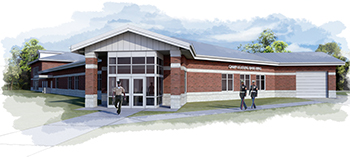First Military Brigade Achieves LEED Gold
 CHARLOTTE, N.C. — The Green Building Certification Institute recently awarded the MCIEAST Regional Brigade at Marine Corps Base (MCB) Camp Lejeune LEED Gold certification. The 75-bed confinement facility, which holds pre-trial individuals, stands as a symbol of the Navy’s commitment to environmentally friendly construction techniques using high-performance designs. The brigade is the military’s first facility to achieve LEED Gold.
CHARLOTTE, N.C. — The Green Building Certification Institute recently awarded the MCIEAST Regional Brigade at Marine Corps Base (MCB) Camp Lejeune LEED Gold certification. The 75-bed confinement facility, which holds pre-trial individuals, stands as a symbol of the Navy’s commitment to environmentally friendly construction techniques using high-performance designs. The brigade is the military’s first facility to achieve LEED Gold.
The project began in March 2010 and was completed in February 2013. Brigadier General Thomas A. Gorry formally dedicated the 24,607-square-foot brigade in August 2012. The total cost of the project was $14,723,821.
The overall goal of the project was to “replace MCB Camp Lejeune’s aging brig with a modern facility meeting [Department of Defense] Level I confinement security facility requirements, American Correctional Association (ACA) standards and the requirements of SECNAVINST 1640.9C (Navy Corrections Manual),” said Emmett Ahearn, vice president and director of federal projects at Moseley Architects, with offices in Charlotte. The project met all of the requirements in addition to complying with LEED Gold criteria.
The new brig features many elements of sustainable design and technology. Ground-coupled heat pumps link to 78 geothermal wells, solar power generates heat for water, LED site lighting reduces the costs and density of artificial lighting, and a reflective metal roof with R24 insulation helps regulate the building’s temperature. A continuous air barrier system also resulted in a 39 percent energy saving, which surpasses the Energy Policy Act of 2004’s requirements of 30 percent.
Additional design elements include precast concrete walls, ceilings and cell modules that improved thermal massing and reduced construction waste, water-conscious plumbing, Energy Star-qualified food service equipment and Stormwater Best Management Practices that help the brig protect water quality by collecting the water on site. The project team also managed to divert 97 percent of the waste generated during construction work to the recycling center in Camp Lejeune and used building materials containing recycled and regional content.
The team did face several challenges while working on the project, one of which was designing a building that would comply with LEED Gold requirements. Another challenge was withstanding the numerous changes the project underwent throughout the projected timeline. “Change is especially difficult because the allowable space limits are dictated per the Naval Facilities Engineering Command Request for Proposal (NAVFAC RFP),” Ahearn said. “The scope and program requirements were developed years earlier and as new leadership and personnel changed during the project timeline, so did the preference of a floor plan.”
 For example, the facility’s commanding officer changed during the project’s construction phase. The change resulted in a new vision for the facility operations and a stronger need for individual workspace that required a strong team effort to produce a successful solution during the construction, according to Ahearn.
For example, the facility’s commanding officer changed during the project’s construction phase. The change resulted in a new vision for the facility operations and a stronger need for individual workspace that required a strong team effort to produce a successful solution during the construction, according to Ahearn.
Ahearn attributes the success of the project to the design-build team, which he claimed was the ultimate key in being able to see the project through to completion. He said that individual team members such as Sustainability Coordinator John Nichols and Paul Luzier, the construction contract administrator, made the team’s success possible.
Working with NAVFAC’s sustainable design knowledge and detailed LEED requirements provided a significant change from other projects Moseley Architects has worked with. “Where some owners have a more general requirement for a certain LEED rating, the Navy and other branches of the military have gone above and beyond to specify particular LEED credits and other environmental requirements they expect to be achieved. The Enviro AgScience JV project team therefore paid very close attention to these requirements from the initial RFP all the way through the end of construction, which enabled us to constantly monitor our compliance,” Ahearn said.
MCIEAST is Moseley Architects’ 52nd LEED-certified project.
